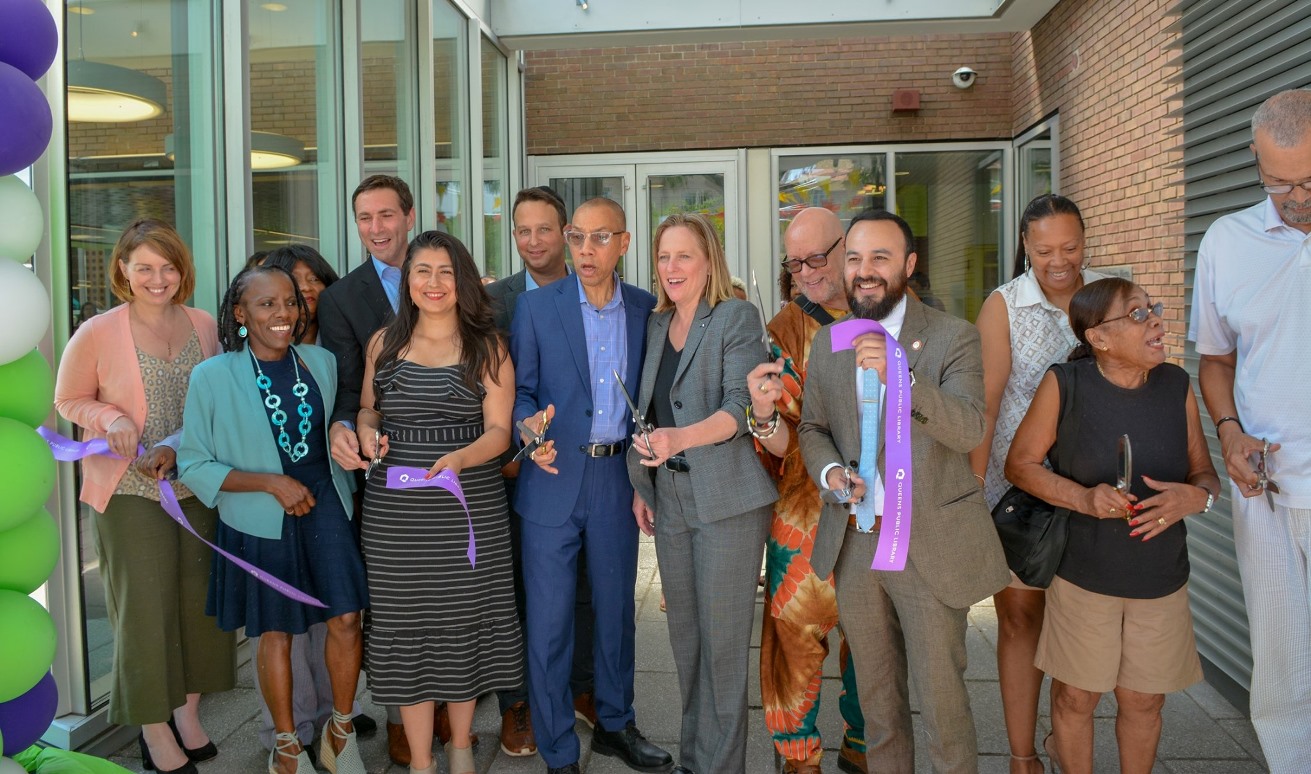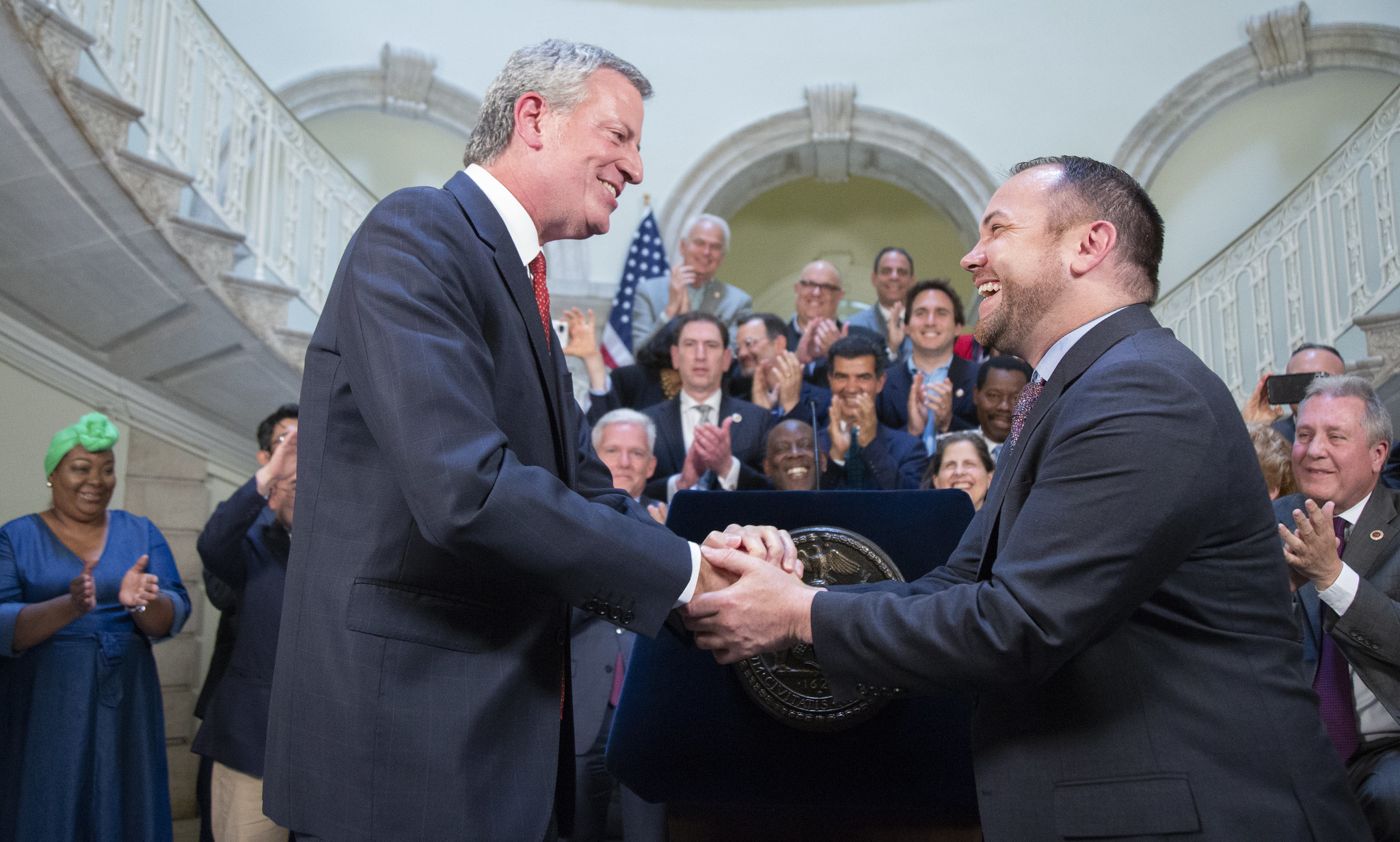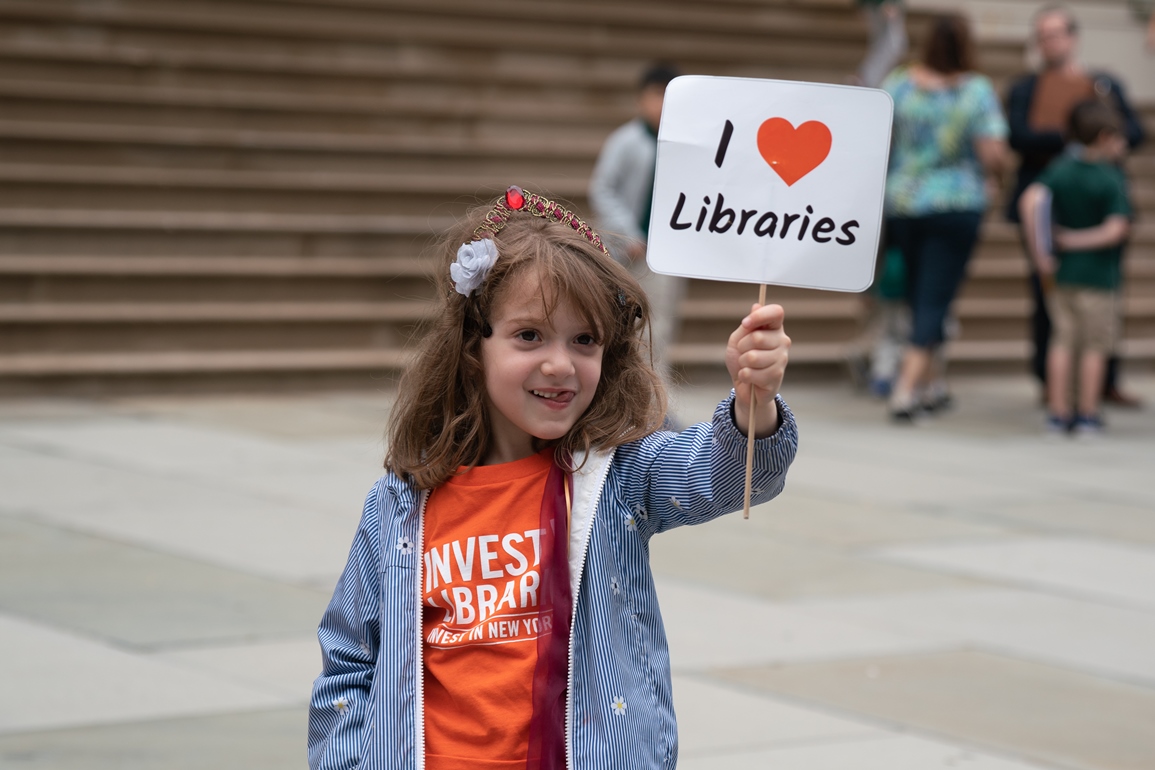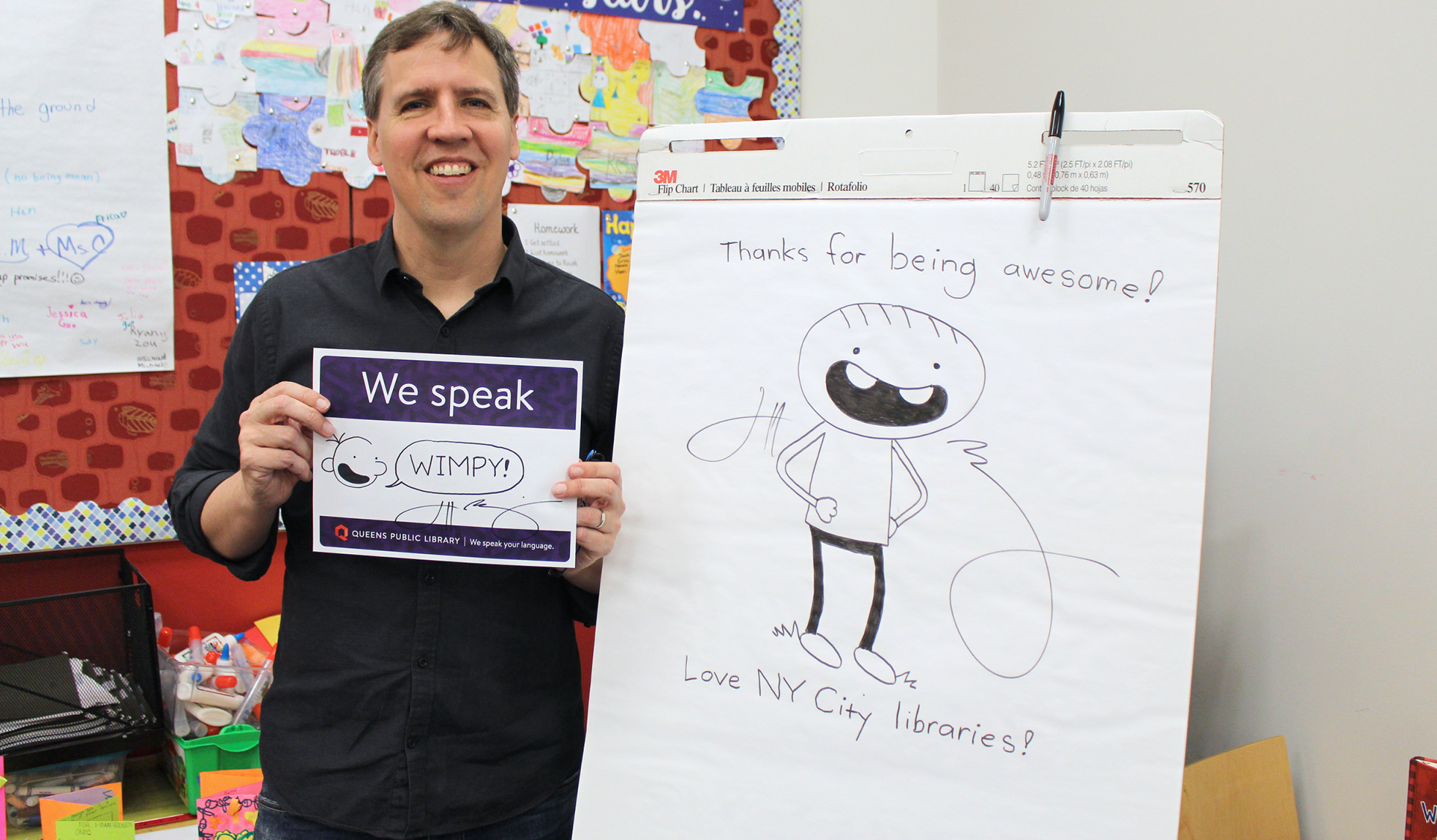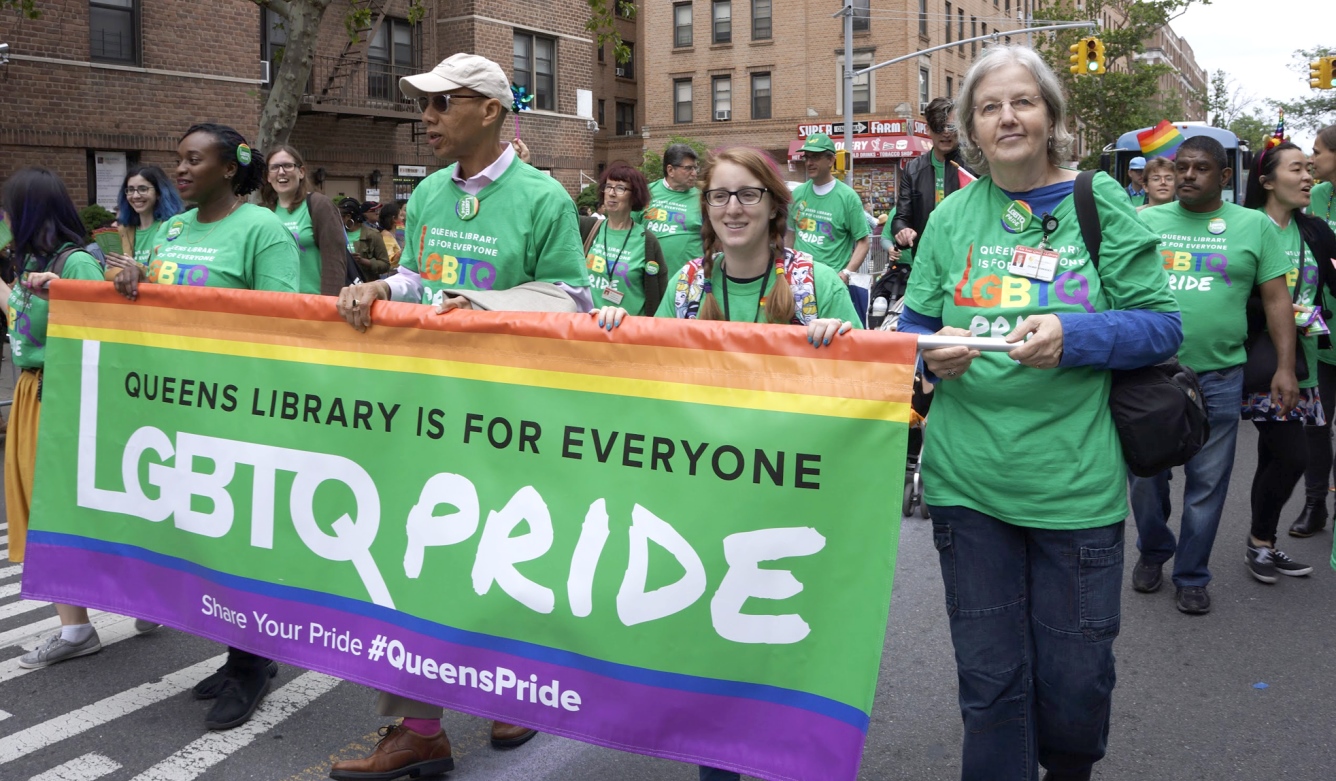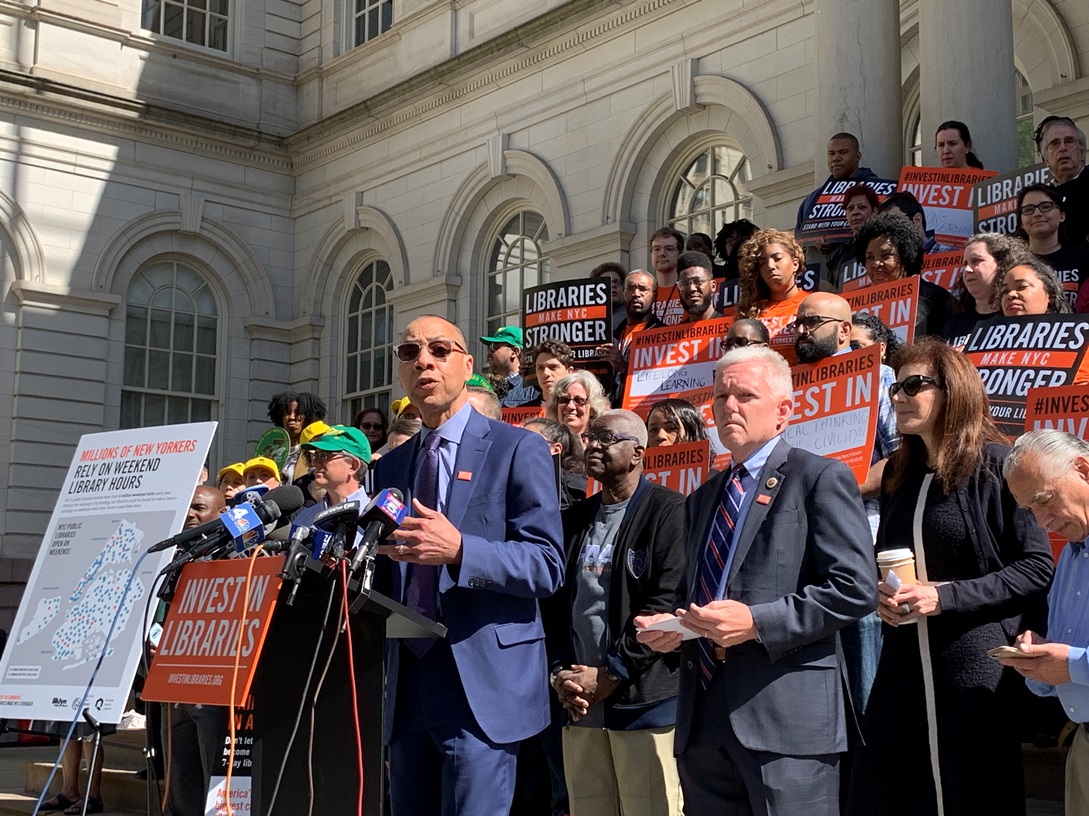The Queens Memory Project invites you to Making Community Story Quilts, a new exhibit at the Queens Museum featuring artwork created during their 2017 and 2018 story quilt workshops.
These multi-session workshops invited people from the Fresh Meadows and Flushing library communities to create “talking” story quilts that combine textiles and technology to tell the visual and oral histories of their families’ migrations to the United States.
Also included in the exhibit is an ongoing embroidery map of Queens that visitors can interact with to add their stories and mark their own significant places in Queens.
“Many of the participants who made the artwork in this exhibition are going to be with us on Saturdays and Sundays from 1-3pm during the course of the exhibit to greet visitors and help them interact with the pieces," said Natalie Milbrodt, Queens Public Library's Coordinator of Metadata Services and the Director of Queens Memory. "It’s going to be a fun reunion and a great opportunity to extend the reach of the artistic community we built through our Memories of Migration workshops.”
Making Community Story Quilts is at the Queens Museum from July 7 to July 28, with an opening reception on Sunday, July 7th from 1pm to 3pm and a storytelling game on July 28th from 1pm to 3pm. We hope to see you there!
East Elmhurst, NY, June 28, 2019—Queens Public Library (QPL) and the NYC Department of Design and Construction (DDC) joined with the community and local elected officials today to celebrate the re-opening of the East Elmhurst Community Library after a $9.9 million expansion and renovation that was managed by DDC for QPL.
“The renovation and expansion have transformed East Elmhurst Library into an even more inviting oasis of learning and opportunity for all,” said Queens Public Library President and CEO Dennis M. Walcott. “With more room for books, periodicals, computers and programs, the branch is sure to become busier than ever before. We are extremely grateful to our current and former City leaders for securing the capital funds needed to cover the cost of the project, including Mayor Bill de Blasio, Queens Borough President Melinda Katz, the late Queens Borough President Helen Marshall, Council Member Francisco Moya and former Council Member Julissa Ferreras-Copeland. I also would like to commend DDC Commissioner Lorraine Grillo and her team for their hard work in delivering a spectacular building to the community.”
“Libraries are important centers of community learning and community gathering, and the expanded East Elmhurst Library will serve this community well for decades to come,” said DDC Commissioner Lorraine Grillo. “The project team did a remarkable job executing a design that is efficient yet elegant, resulting in a beautiful new facility that also meets the standards for LEED Silver certification.”
“The families of East Elmhurst deserve a state-of-the-art library worthy of the 83,000 people who walk through its doors each year. With today’s grand opening of this newly expanded and upgraded library branch, that’s exactly what this community will enjoy for years to come,” said Queens Borough President Melinda Katz. “Our libraries are the anchors of our neighborhoods, and East Elmhurst’s beautiful new center for learning, literacy and culture is something all residents can be proud to call their own.”
“I couldn’t be happier to see this project finally come to fruition and for the new, state-of-the-art East Elmhurst Community Library to re-open its doors to the public,” said Council Member Francisco Moya. “Libraries are public cathedrals—temples for exploration and discovery. Not only are they repositories for literary works but for so many people, our libraries are their best portals to internet access. I also want to commend the library and the Department of Design and Construction for developing a facility with climate change and sustainability in mind. I’m proud to have helped fund this project and I applaud all those who made this possible.”
“I am so happy to help celebrate the newly expanded and renovated East Elmhurst Community Library,” said Assemblymember Jeffrion Aubry. “I encourage families to make use of the many enhanced features such as an extended and modernized teen area, and a new state-of-the-art community meeting room. The library also boasts a new enclosed open space, perfect for reading a good book anytime of the year. I would like to thank Borough President Melinda Katz, Mayor Bill de Blasio, Council Member Francisco Moya and former Council Member Julissa Ferreras-Copeland for making this possible. Special thanks to former East Elmhurst library manager Johnnie Dent. Without her vision and tenacity this day would not have happened. And thank you to Helen Marshall, former Borough President, who supported our dream no matter what.”
“We are elated to see this long awaited project come to fruition,” said Community Board 3 District Manager Giovanna Reid. “We thank everyone that played a role in bringing about this first-class state-of-the-art facility to our community.”
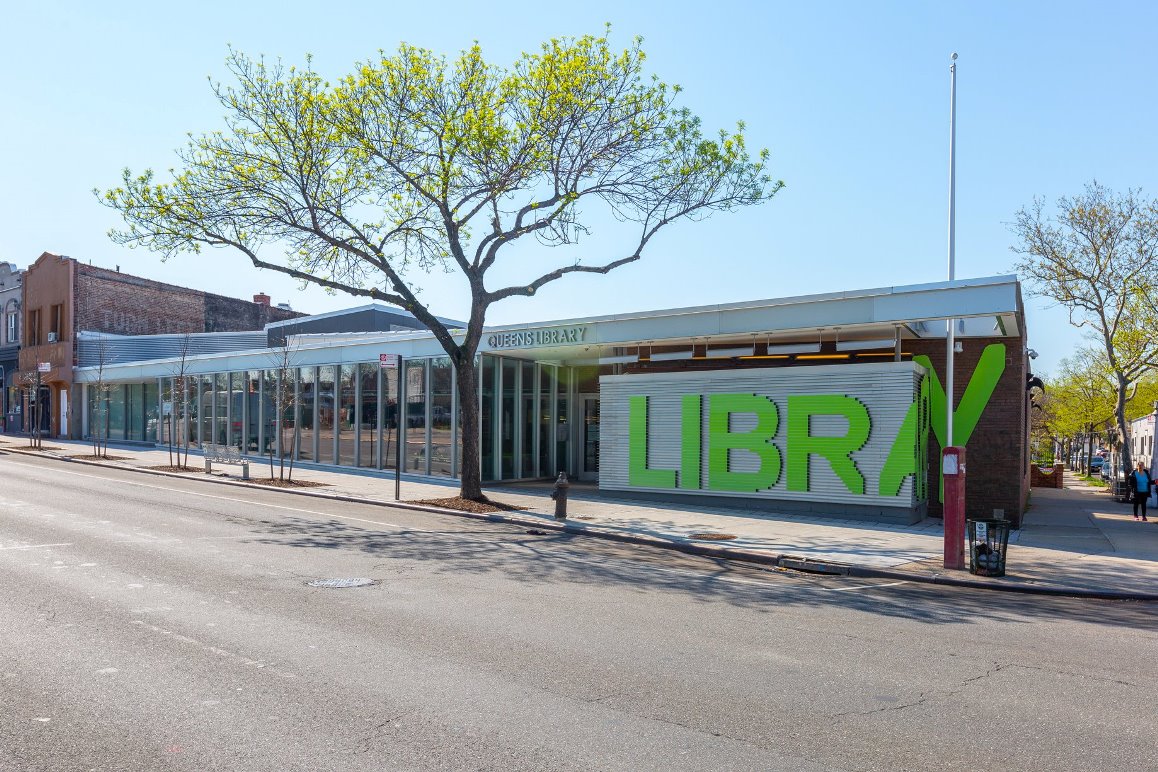
The East Elmhurst Community Library at 95-06 Astoria Boulevard opened in 1972 as a 7,352-square-foot brown brick structure. The project added 4,290 square feet of space to the building, including an interior courtyard with an underground irrigation system and a reading space. In the rear of the building the project added a new 1,665-square-foot patio and garden area.
The old façade of the building has been enclosed inside a continuous glass wall along Astoria Boulevard. An expanded teen area was added to the facility with computers and lounge seating, plus reading tables and benches. A new meeting room was also added for up to 173 people with a separate entrance for after-hours access for the community and state-of-the-art audio/visual equipment. The additions include a pantry for food preparation plus two new restrooms. In the original part of the building, the layout of the adult room was enhanced and new furniture was installed.
The new structure is anticipated to meet the standards for LEED Silver certification and contains several sustainability features including skylights for natural lighting, natural air ventilation, active heat recovery ventilation and insulated glazing that uses a suspended plastic film to triple the building’s thermal resistance.
Borough President Melinda Katz allocated $3 million for the project, adding to $4 million previously allocated by the late Borough President Helen Marshall, with the remaining $2.9 million from Mayor Bill de Blasio, Council Member Francisco Moya and former Council Member Julissa Ferreras-Copeland.
The general contractor for the project was National Environmental Safety Co. of New Hyde Park. Design was by Garrison Architects of Brooklyn. Also contributing to the project were Robert Sillman Associates (structural), Plus Group Engineering P.C. (mechanical, electrical and plumbing), Wohl & O’Mara LLP (civil), Judith Heintz (landscape) and Cline Bettridge Bernstein LD (lighting).
###
About the NYC Department of Design and Construction
The Department of Design and Construction is the City’s primary capital construction project manager. In supporting Mayor de Blasio’s long-term vision of growth, sustainability, resiliency, equity and healthy living, DDC provides communities with new or renovated public buildings such as such as firehouses, libraries, police precincts and new or upgraded roads, sewers and water mains in all five boroughs. To manage this $14 billion portfolio, DDC partners with other City agencies, architects and consultants, whose experience bring efficient, innovative and environmentally-conscious design and construction strategies to City projects. For more information, please visit nyc.gov/ddc.
About Queens Public Library
Queens Public Library is one of the largest and busiest public library systems in the United States, dedicated to serving the most ethnically and culturally diverse area in the country. An independent, non-profit organization founded in 1896, Queens Public Library offers free access to a collection of more than 5 million books and other materials in multiple languages, technology and digital resources, and more than 87,500 educational, cultural, and civic programs a year. It consists of 65 locations, including branch libraries, a Central Library, seven adult learning centers, a technology lab, two universal pre-kindergartens, and two teen centers.
Media Contacts:
QPL: Ewa Kern-Jedrychowska, 718-990-0706, ekern@queenslibrary.org
DDC: Ian Michaels, 718-391-1589, MichaelsI@ddc.nyc.gov
Tags
After careful consideration, starting July 1, 2019, Queens Public Library will no longer offer customers free access to Kanopy, the video streaming service.
While we understand that some cardholders enjoyed this service, the increasing cost of Kanopy and the need to devote our resources to other priority services and materials that are in higher demand, such as books, e-books, and DVDs, make it unsustainable.
Video streaming is still available through Overdrive, our digital media provider, and DVDs are still available at all our branches. We also will continue exploring other options for video streaming services. In addition, next month we will start welcoming DVD purchase suggestions as part of our materials request program.
We apologize for any inconvenience and thank you for your understanding.
Statement on the City’s Fiscal Year 2020 Budget
by Queens Public Library President and CEO Dennis M. Walcott,
Brooklyn Public Library President and CEO Linda E. Johnson,
and The New York Public Library President and CEO Anthony Marx
FOR IMMEDIATE RELEASE: June 14, 2019
We are extremely grateful to Mayor de Blasio, City Council Speaker Corey Johnson, and the entire City Council for investing $33 million in additional expense funding for the City’s public libraries. This crucial support will allow us to continue providing essential services in the face of rising costs, growing footprints, and increased demand.
We recognize the passionate advocacy of Speaker Johnson, Finance Chair Danny Dromm, and Cultural Affairs & Libraries Chair Jimmy Van Bramer, who have prioritized our vital institutions in a difficult budget year. On behalf of our millions of patrons and the hundreds of thousands who signed letters, called their representatives, and attended rallies to fight for their libraries, thank you for standing with us. We also applaud our staff members and union leaders for galvanizing tremendous support citywide.
You have collectively ensured that public libraries—which offer opportunity to all and are the heart of a fair and equitable city—remain strong at a critical time in our history, when New Yorkers, especially the most vulnerable, need them the most.
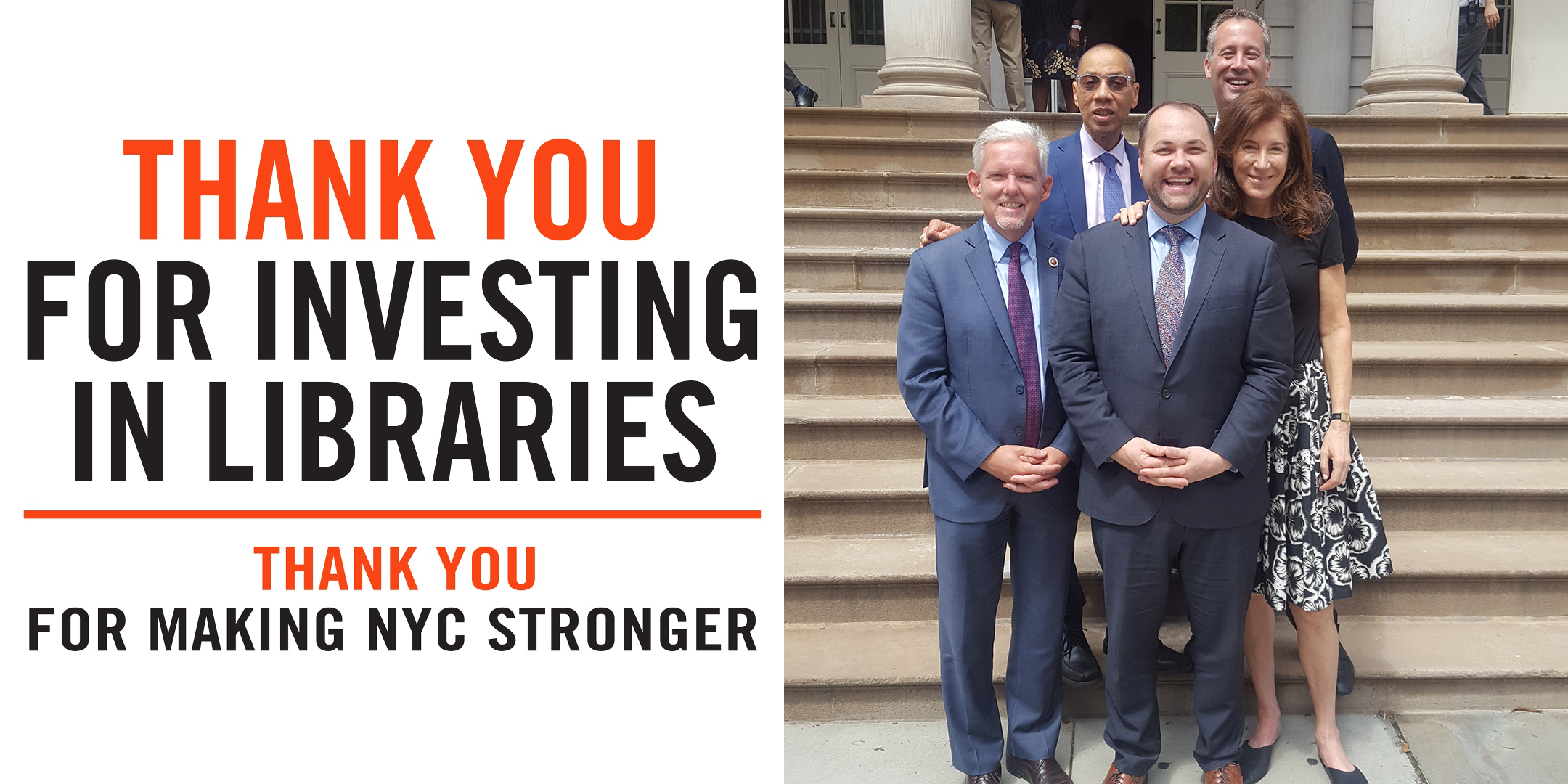
Pictured at top: Speaker Corey Johnson and the NYC Council join with Mayor de Blasio for Budget Handshake. Photo by John McCarten.
Pictured above: Queens Public Library President and CEO Dennis M. Walcott, New York Public Library President and CEO Anthony Marx, and Brooklyn Public Library President and CEO Linda E. Johnson, with Cultural Affairs & Libraries Chair Jimmy Van Bramer (front left) and Speaker Corey Johnson (front center).
This year, Kenneth C. Davis, author of books about American history, visited eleven schools in Queens in a series organized by the MyLibraryNYC program.
More than 2,000 students and adults attended the author’s presentations, where he primarily spoke about two of his books, In the Shadow Of Liberty, on presidents who owned slaves, and More Deadly Than War, about the connection between the Spanish flu and World War I.
Davis, who had planned to be a teacher, became a writer after working in a bookstore. A woman who worked with him told him he was wasting his time selling books, and he ought to be writing them. He took her advice—and married her.
His first book was a history of paperback publishing in the United States, the story of how the widespread availability of books changed and democratized reading. Davis considers himself “a child of the library” and even now visits the library three to five times a week. The library is both his go-to place for research and where he gets videos for his grandchildren.
“The library plays a very central role in my life,” he says. “I have always understood that the library is central as a part of our civic society.” Davis believes that many of our problems today come from fake news and propaganda, and that libraries are the places “that can help inoculate us against that.”
His presentation about the Spanish flu emphasized the way that science and society are connected, and how the movement of troops spread the flu around the world. In one year, more Americans died of the flu than had died in all of the twentieth-century wars put together. Davis also referenced two famous Americans who survived the flu—Walt Disney and Franklin Delano Roosevelt—and asked audiences to imagine how the world would be different without them. In his presentation on presidents who were slave owners, Davis invited students to ponder the contradiction of a country “conceived in liberty that was also born in shackles.”
Kenneth C. Davis at the Frank Sinatra School of the Arts in Astoria.
Describing his research process, Davis says, “It’s very idiosyncratic. I start with a lot of reading. I always discover that little piece of the story that I’ve never heard before. The research process is going in new directions I didn’t anticipate.”
Although he writes mostly for younger people, the author says he would write his books in the same way for adults: “The key is to take ideas and present them in a way that’s accessible, even conversational. Find contemporary references and analogies. Look for things in pop culture that connect with people.”
Davis remains keenly interested in stories that were not in his schoolbooks. He believes we are in a golden age of very good historians writing popular nonfiction and credits David McCullough for getting him interested in history in a way that he had never been before “because he gave it this incredible human element.” Other historians he looks to as models include David Halberstam, Doris Kearns Goodwin, H.W. Brands, and Harrison Salisbury.
Davis may not have become a teacher, but he spends a lot of time teaching young people. Since 2011, he’s done more than 300 classroom visits by Skype, discovering along the way that he “really loved talking to young people.” “There’s an idea that young people aren’t interested in history,” he says. “My whole career has been about disproving this.”
The pleasant surprise about visiting public schools in Queens was how incredibly engaged his audiences were. Noting a visit that he did with 400 middle grade students, he says there wasn’t time to answer all of the students’ questions. “I think that the most important thing I’ve done in my career is ask questions. The questions the kids ask are always the best part of the presentation,” Davis says. “Being curious and asking questions is the most important thing any of us can do. That’s what I’ve tried to do in my writing career—ask good questions.”
Kenneth C. Davis’s In The Shadow of Liberty and More Deadly than War are both available at Queens Public Library.
This spring, Kwame Alexander spoke to a rapt audience of fourth and fifth graders at PS 48 in Queens as part of a program that Queens Public Library organized through South Jamaica Reads to bring authors to schools.
Bestselling author Alexander says he owes his success to librarians. Alexander won the Newbery Medal in 2015 for his first novel-in-verse The Crossover. He describes his parents as his first librarians, saying there were books everywhere in the house he grew up in, where “books were reward and punishment. Books were places we could discover who we wanted to be, discover faraway places we haven’t been.” Libraries, he says, “were churches almost, temples of possibilities.”
To Alexander, reading means “entertainment, fun, thrill, fantasy. And it means information. Reading is intelligent entertainment.” In a new role, he’s now publishing an imprint called Versify. “I look for books that are going to help young people imagine a better world,” he says. “I look for books that are going to be page turners and books that are going to inspire.”
Alexander believes in the power of poetry to change lives—and tells a story about how it impacted him: “It got me married. I wrote a poem a day for this woman and she ended up marrying me. That was how I courted her. That’s how poetry changed my life on a very personal level. I’ve seen how it can transform and connect with people and ultimately allow people to be more human. I’ve seen it in kids around the world and I’ve seen it in my own household.”
He says, “A lifetime of experience and observation and books and travel inspired me to want to be a writer.” Muhammad Ali’s autobiography made reading cool for him, and he thinks he can make literature and poetry cool for kids: “I want to impart and share that with young people. I feel that I’m the guy to do that because I’m a cool dude.”
Alexander speaks about the power he feels books have to overcome barriers between people: “I want white police officers to have an imagination that’s beyond stereotype and trope and prejudice.” He believes that if they had read Walter Dean Myers, Jacqueline Woodson, Lucille Clifton, or Mildred Taylor as children, “they’d probably have a whole different connection with black boys and black people. I think that’s important. It starts in childhood.”
Noting that children aren’t shaped in a vacuum, he explains that he grew up in Brooklyn public schools reading a lot of books featuring white boys and characters, but his white friends didn’t read about a lot of characters who were black. “We should find out about ourselves, so books should be mirrors, and we should find out about people who are not us, who are different from us so we can find out what those similarities and connections are, so books should be windows as well,” he says. “We should learn about our neighbors.”
Alexander expresses frustration that books featuring black characters are perceived as being for black children. “That’s cool,” he says, “but that can’t be the only thing. Non-black kids have to be able to read these books in order to have this imagination we’re talking about.” He argues that boys should not be directed to only read books about boys and girls should not be directed to only read books about girls. As he puts it, “We need to get beyond that and allow books to help kids connect with their humanity, which embraces America for what it should be.”
Alexander’s mantra is to say yes—“Say yes to possibility, say yes to yourself, walk through doors even if you don’t know what’s on the other side, and when you get there, figure it out.”
His new book The Undefeated, which he describes as a love letter to black America, is available now at Queens Public Library.
Story times and other key programs at risk if libraries do not receive $35 million in additional operating funds this budget season
Photos available here (credit Jonathan Blanc / NYPL)
New York, NY – The city’s three library systems held a special toddler story time outside City Hall this morning to call attention to the kinds of programs and services that could be cut if libraries lose out this budget season.
Dozens of children and their caregivers packed the plaza outside of City Hall to sing songs and hear stories read by librarian and Urban Librarians Unite Executive Director Christian Zabriskie; City Council Speaker Corey Johnson joined in and read Too Many Carrots by Katy Hudson.
The story time showcased the kinds of important early literacy programs at risk if the current proposed city budget goes through: New York City libraries are currently slated to receive an $11 million cut in the Fiscal Year 2020 budget. They requested $35 million in additional funds to cope with rising costs, growing footprints and increased need. Libraries are also seeking the funding necessary to play a key role in the high-stakes 2020 Census. If the situation does not change, libraries warn of a potential loss of weekend service, hours and programs.
In Fiscal Year 2018, libraries had over 1.1 million visits to free early literacy programs including story times; about 10 percent of that attendance came on weekends.
“The city’s libraries are among the most democratic institutions in New York. We welcome everyone—older adults seeking companionship and immigrants seeking a new start. We provide teens a safe space after school and free WI-Fi to do their homework. We give families a warm place to stay on a cold day, and everyone access to books and information,” said Linda E. Johnson, President and CEO, Brooklyn Public Library. “We extend our thanks to Speaker Corey Johnson for his outspoken commitment to the full funding of the city’s libraries and urge other city leaders to reverse proposed cuts and fully fund the city’s libraries to keep pace with the soaring demand for services in libraries in every city neighborhood.”
"We know libraries can open doors—but not if they're closed," said New York Public Library President Anthony W. Marx. "If we are forced to cut back days of service or hours as a result of this year's budget, that means fewer early literacy programs—like story time—that help children prepare for school, develop social skills and generate a lifelong love of reading. As these programs also strongly support the City's educational priorities and goals, we are asking our partners in government to consider continuing investing in libraries so we can keep our doors open to help all New Yorkers, including our youngest."
“As city officials negotiate the budget, we hope that this story time on the steps of City Hall reminds them that while libraries are essential to child development and school readiness, they need adequate funding to continue providing people with the programs and services that will enable them to learn and grow,” said Queens Public Library President and CEO Dennis M. Walcott. “We are grateful to Speaker Corey Johnson, Finance Chair Danny Dromm, Libraries Chair Jimmy Van Bramer and the City Council for demonstrating their support today and for understanding the role of libraries in the lives of New York communities.”
"Kids and families have a right to have quality programming every day of the week,” said Urban Librarians Unite Executive Director Christian Zabriskie. “Librarians can't do amazing programming when given partial resources. Story time for all kids is a right, not a privilege."
In addition to operating funding, the City’s three library systems are also asking for $150 million in capital funds to address significant infrastructure needs that were not included in the 10-year capital plan, and to help with ongoing maintenance of branches across the city that are in need of new roofs, boilers, air conditioners and more.
The libraries have received support for their budget ask this year from nationally-syndicated radio host Angela Yee, best-selling author Jennifer Egan, and most recently, New Yorker and library patron Sarah Jessica Parker, who channeled her Sex and the City character Carrie Bradshaw when she wrote, “So. I couldn't help but wonder, could I as a New Yorker accept cuts to our wonderful, important, necessary, and beloved libraries? I'm sorry. I can't.”
New Yorkers have also signed over 70,000 letters to Mayor de Blasio and City officials calling for increased library funding. Letters can be signed in branches or at investinlibraries.org.
The passion for libraries should not be surprising: an online poll of more than 1,000 New Yorkers conducted by firm Change Research made it abundantly clear: New Yorkers feel public libraries are irreplaceable cornerstones of New York City, especially for the city’s most vulnerable. Key takeaways include:
- 93 percent feel libraries are important to New York City
- 95 percent agree that libraries further many important initiatives for New York City
- 93 percent agree that libraries are a cornerstone of all New York communities
- 84 percent agree libraries should receive an increase in funding
- 97 percent feel that libraries most benefit populations like children, immigrants, and disadvantaged & lower income people
- 95 percent said that their community would be negatively impacted without the library.
About the Campaign
The #InvestInLibraries campaign is a partnership between the city’s three public library systems—Brooklyn Public Library, The New York Public Library and Queens Public Library—and other library supporters across the city. Since the campaign launched in 2015, the City has allocated additional funding for programming as well as critical capital dollars to help address the over $1 billion in need facing the city’s aging library infrastructure. Despite this important support, libraries confront rising costs and increased demand for more services and programs (from New Yorkers and the City). The campaign urges the City to restore and increase funding to meet rising needs, demands, and costs.
Jeff Kinney, the author of the bestselling Diary of a Wimpy Kid series, visited Queens Public Library on April 9, the day he launched his new book, Diary of an Awesome Friendly Kid: Rowley Jefferson’s Journal.
When Kinney completed the book, he and his team pondered fun and thoughtful ways to launch it. Unlike the previous Wimpy Kid books, Diary of An Awesome Friendly Kid is written from the perspective of Rowley Jefferson, the ever-cheerful best friend of Diary of a Wimpy Kid protagonist Greg Heffley.
The team decided to focus the launch on Rowley’s good nature. To highlight his friendliness, Kinney would go on a book tour and ride an “Awesome Friendly Party Bus” across New York City and New Jersey, meeting with over 40 “awesome friendly people” during the first week of the book’s publication.
He found many of these people right here, at Queens Public Library, where his books had claimed the first nine spots among the top 10 most frequently checked-out children’s books and overall books in 2018.
QPL got on his radar after he had learned about the Library’s “It’s Time for Kind” campaign, a series of programs and activities held over the 2018 holiday season that gave the public and our staff opportunities to spread and perform acts of kindness, ranging from sending messages to hospitalized children and troops overseas to making blankets for animals at shelters.
Students attending our STACKS after-school program at Flushing Library, who as part of the campaign had made cards and bookmarks for the library’s homebound customers, instantly caught Kinney’s attention.

“We heard about you guys all the way in Massachusetts, and we really wanted to thank you for what you’re doing here,” Kinney told the children during his visit. “You used your free time to help people who don’t get to get out to the world, and what’s really cool about what you’re doing is that every time they see that card it makes them happy again.”
Kinney, whose books have sold 200 million copies worldwide and been made into four feature films, also spoke with the children about the importance of being kind. He then showed them how to draw Rowley and answered their questions, reassuring them that they don’t have to worry about the future adventures of their beloved characters.
“When will you stop making books?” one child asked. “When I die, and hopefully that won’t be anytime soon,” Kinney quipped.
Kinney also met with QPL’s first and only correctional services librarian, Nili Ness, who delivers books and other reading materials to Rikers Island inmates and monitors Video Visitation, a program which allows families to visit via video calls with relatives incarcerated at Rikers, so they don’t have to make the difficult trip to the jail.
The author also made a stop at our Bellerose branch to meet with its knitting club. Headed by Senior Librarian Qamar Jaffery, the club donates hats to homeless shelters and to local hospitals for their cancer patients.
Thanks for your visit, Mr. Kinney. It was an Awesome Friendly Day at Queens Public Library!
Pictured above: Jeff Kinney with the STACKS after-school students at Flushing Library, QPL correctional services librarian Nili Ness, and the Bellerose Library Knitting Club.
Queens is a vibrant place, home to 2.3 million people who speak nearly 200 languages, believe in every faith, love in every way, and are loud and proud!
In June, with the theme of “Let’s Make Some Noise,” Queens Public Library is going to celebrate our LGBTQ community and the 50th anniversary of the political protests at NYC’s Stonewall Inn, which are seen as the birth of the modern American LGBTQ Pride Movement.
With an array of events that span from author talks and panel discussions to silent dance parties and sing-your-heart-out sing-alongs, information workshops, legal clinics, open mics, performances, and so much more, Queens Public Library is picking up its rainbow megaphone!
As we did last year, Queens Public Library will march in the Queens Pride Parade in Jackson Heights on Sunday, June 2, and the NYC Pride Parade in Manhattan on Sunday, June 30.
Our Queens Memory Project will create displays of Queens Pride Stories at our branches where people can share handwritten notes describing their stories of coming out, supporting the LGBTQ community, and more.
Since love knows no color, shape, or form, customers will have the chance to use colorful paper, markers, and their imaginations to make hearts, or whatever shape they think love has, and add their creations to the Love Is Love Is Love collages at our branches.
Teens can color LGBTQ flags and help hang them in our libraries as a visual representation of LGBTQ people in our community.
Parties and silence don’t usually go together, unless the party venue is your favorite library! Teens will put on their party shoes and headphones and move to the rhythm at Silent Dance Parties for Teens (which won’t disturb the rest of our patrons) at our Cambria Heights, Forest Hills, Queens Public Library for Teens, and Woodside locations.
Our Ask Me Anything panels will aim to take away the awkwardness of asking personal questions in a public forum. Participants can submit their questions anonymously on a piece of paper, and our moderators will share the questions for discussion. There is no such thing as a foolish question, and everybody will be a little bit wiser after this great opportunity for frank, open, and all-encompassing conversations about the LGBTQ community.
At our LGBTQ Information Fair on June 10 at Central Library in Jamaica, health, legal, and social services providers and LGBTQ-positive organizations will gather and offer advice, referrals, and information for our LGBTQ customers and their supporters.
These are just some of the great activities we have planned for LGBTQ Pride Month; to see our full schedule, visit our homepage this June!
Tags
Libraries Requesting $35 Million to Keep Up with Growing Demand and Pay for Rising Costs; Rally with Elected Leaders & Advocates on the Steps of City Hall, Part of Their Ongoing “#Invest in Libraries” Campaign
New York, NY – Facing possible cuts in the city budget, leadership from the city’s three library systems, elected officials and advocates gathered on the steps of City Hall today to warn of a dramatic impact should funding to the library systems be reduced—including loss of weekend service, smaller collections, reduced programming and delayed revitalization projects.
The lack of inclusion of the city’s libraries in City Hall’s ten-year capital plan is also likely to compound the problem. The three library systems are asking for $150 million to compensate, and to help with ongoing maintenance of branches across the city that are in need of new roofs, boilers, air conditioners and more.
"Libraries are doing more than ever before for the people of New York City, including partnering with the City to support its goals and priorities," said New York Public Library President Anthony W. Marx. "To be able to continue this important work while also extending our resources to address the City's growing needs—including reaching hard-to-count communities in the high-stakes 2020 Census—libraries need increased funding, not less. Under the current proposed budget, we will have to drastically cut back hours and days of service, with weekends most at risk. We understand this is a tough budget year—but in tough times, New Yorkers rely on their libraries. We are so grateful to City leaders for recognizing the importance of libraries and relying on us to help provide critical services, and hope that they will continue to invest in libraries."
“There may be no institution in our City serving more people with as wide a variety of services as the Library. Last year, in Brooklyn alone, we provided over 70,000 free programs attended by over 1,000,000 people, including educational and cultural programs, business and career development assistance, services designed to aide immigrants and, of course, literacy services to give children a good and fair start at school and engender a lifelong love of reading, and adult literacy classes to alter the course of the lives of those who are learning to read later in life,” said Linda E. Johnson, President & CEO of Brooklyn Public Library. “I urge city leaders to continue their critical investment in Libraries and the millions of people we serve each year.”
“Libraries are the great equalizers in our society, and the most-equipped vehicle to a fairer and stronger City,” said Queens Public Library President & CEO Dennis M. Walcott. “We need increased funding, not less. We need additional dollars to maintain our current level of service, meet rising costs, repair and upgrade our aging buildings and provide the collections and programs our customers deserve and expect. Cutting the budgets of libraries will undermine our commitment to opportunity for all New Yorkers.”
“Our public libraries are lifelines for NYC neighborhoods—and cutting them by $11 million would jeopardize hours and days of service. We urge City Hall to find a way to keep what amounts to less than half of 1 percent of the city’s budget,” said Henry Garrido, Executive Director, District Council 37.
Libraries across the city are doing more than ever before, from traditional services like storytime to key civic initiatives including support for new Americans. Of particular concern is the 2020 Census; libraries expect to play a central role in helping New Yorkers with the Census, but fear that they will not be provided additional financial support from the city to do this crucial civic work that will help determine federal funding to New York City for the next ten years.
Results of a new online poll of more than 1,000 New Yorkers, conducted by firm Change Research, highlighted the personal connections that New Yorkers have with their libraries, and the overwhelming support behind the full funding of library programming and services.
New Yorkers feel public libraries are irreplaceable cornerstones of New York City, especially for the city’s most vulnerable. Key takeaways include:
- 93 percent feel libraries are important to New York City;
- 95 percent agree that libraries further many important initiatives for New York City;
- 93 percent agree that libraries are a cornerstone of all New York communities;
- 84 percent agree libraries should receive an increase in funding;
- 97 percent feel that libraries most benefit populations like children, immigrants, and disadvantaged & lower income people;
- 95 percent said that their community would be negatively impacted without the library.
“Our city’s public library systems need more funding to keep up with rising costs and demands,” said City Council Member and Chair of the Cultural Affairs and Libraries Committee, Jimmy Van Bramer. “It is undemocratic to propose cuts for libraries at a time of such great need. I will continue to fight any attempt to diminish library services in our communities.”
About the Campaign
The #InvestInLibraries campaign is a partnership between the city’s three public library systems—Brooklyn Public Library, The New York Public Library and Queens Public Library—and other library supporters across the city. Since the campaign launched in 2015, the City has allocated additional funding for programming as well as critical capital dollars to help address the over $1 billion in need facing the city’s aging library infrastructure. Despite this important support, libraries confront rising costs and increased demand for more services and programs (from New Yorkers and the City). The campaign urges the City to restore and increase funding to meet rising needs, demands, and costs.

